Disclosure: We may earn commissions if you purchase products after clicking on a link from our site.
Are you interested in hunting fallow deer? Do you want to learn how to hunt fallow deer? Are you up for the challenge and ready for a trophy-hunting experience? Hunting fallow deer is challenging and will your patience, hunting skills, and physical fitness. In this article, we share information and knowledge to help you hunt one of the exotic animals in Texas.

Table of Contents
Fallow Deer History
Fallow deer have a rich history that dates back thousands of years, originating in Western Asia and parts of Europe. These elegant and adaptable animals were prized for their meat, hides, and antlers, and were often kept in parks and estates for hunting and ornamental purposes by royalty and nobility.
The fallow deer’s association with human settlements and its docile nature facilitated its spread across Europe, where it became established in various habitats ranging from woodlands to open grasslands. In the United States, fallow deer were introduced primarily for ornamental and game hunting purposes.
The first documented introduction of fallow deer to the United States occurred in the 19th century, with subsequent introductions taking place in different regions across the country. Today, fallow deer can be found in various states, particularly in areas with suitable habitats and climates conducive to their survival.
While not native to the United States, fallow deer have become well-established and valued game animals, contributing to the diversity of wildlife and providing recreational hunting opportunities for enthusiasts across the country.
How To Hunt Fallow Deer
1. Scouting Fallow Deer
Scouting fallow deer is a critical aspect of preparing for a successful hunt, requiring hunters to thoroughly survey potential hunting areas to gather information about deer behavior, movements, and habitat preferences. Hunters typically begin scouting by identifying suitable habitats such as woodlands, grasslands, or agricultural fields where fallow deer are known to frequent.
Using binoculars or spotting scopes, hunters carefully observe these areas from vantage points such as hilltops or elevated stands to detect signs of deer activity, such as tracks, droppings, bedding sites, or antler rubs. Trail cameras can also be deployed to monitor deer movement patterns and identify specific individuals or trophy-quality specimens.
Additionally, hunters should pay attention to food sources such as crops, browse, or natural forage, as fallow deer are highly selective feeders and often concentrate around preferred food sources. By conducting thorough and methodical scouting efforts, hunters can gain valuable insights into the behavior and movements of fallow deer, allowing them to strategize their hunting approach and increase their chances of a successful harvest.
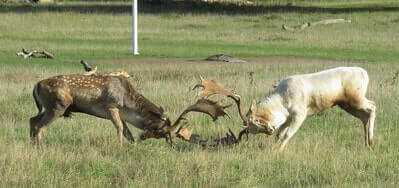
2. Predator Calls
Using predator calls when hunting fallow deer can be a strategic approach to elicit curiosity or alarm responses from these cautious animals. While fallow deer are not typically considered prey for predators like coyotes or foxes, they may still respond to predator calls out of curiosity or a desire to assess potential threats.
Hunters can utilize predator calls that mimic distress or territorial sounds of small mammals or birds to attract fallow deer, particularly during the pre-rut or rutting season when deer are more active and responsive to stimuli. However, it’s essential to exercise caution and use predator calls sparingly and judiciously to avoid overcalling, which may spook wary deer or educate them about the presence of hunters.
Additionally, hunters should complement the use of predator calls with other hunting techniques such as scouting or stalking to maximize their effectiveness in pursuing fallow deer. Overall, while predator calls may not be a primary method for hunting fallow deer, they can be a valuable tool in a hunter’s arsenal when used strategically and in conjunction with other hunting tactics.
3. Spot & Stalk
The spot and stalk hunting method is a popular and effective approach when pursuing fallow deer, particularly in open or semi-open habitats where visibility is good. Hunters employing this method typically begin by scanning the landscape from elevated vantage points such as hillsides or ridges to locate fallow deer feeding or moving about in the distance.
Once a deer is spotted, the hunter carefully plans a stalk, using available cover such as vegetation, terrain features, or natural contours to conceal their approach and minimize their visibility. Stalking requires patience, stealth, and keen observation skills as hunters must navigate quietly and avoid alerting the deer to their presence.
As the hunter closes the distance, they must remain vigilant for any sudden movements or changes in the deer’s behavior, adjusting their approach accordingly to maintain concealment and ensure a successful shot opportunity.
The spot and stalk method requires a combination of skill, patience, and adaptability, but it offers hunters an exhilarating and rewarding hunting experience as they match wits with these elusive and majestic animals in their natural habitat. If you are interested in scopes, we reviewed the best hunting binoculars and the best spotting scopes on the market today.
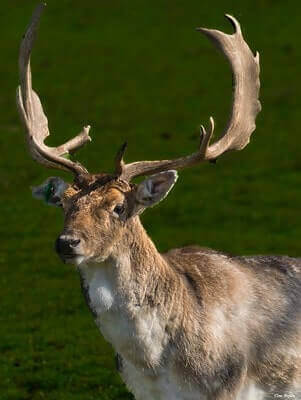
4. Hunting with Dogs
Hunting fallow deer with dogs can be an exhilarating and effective method, particularly in dense or challenging terrain where deer may be difficult to locate or flush out. Specially trained hunting dogs, such as scent hounds or flushing breeds, are utilized to track, chase, and corner fallow deer, ultimately aiding in their pursuit and capture.
The dogs work in tandem with the hunters, using their keen sense of smell and instinctual hunting abilities to detect the presence of deer and drive them towards waiting hunters. Once the deer are located, the dogs may bark or chase them, causing them to flee in the direction of the hunters.
This method requires skilled coordination between the hunters and their dogs, as well as careful training and control to ensure the safety of both the animals and the hunters involved. While hunting fallow deer with dogs can be a thrilling and efficient approach, it’s essential to adhere to ethical hunting practices and local regulations to ensure a responsible and sustainable hunting experience. If you are interested in learning how to train a dog to track deer, then read this article.
5. Hunt With A Guide
Hunting fallow deer with a guide can significantly enhance the hunting experience for both novice and seasoned hunters alike. Guides are experienced professionals who possess intimate knowledge of the local terrain, deer behavior, and hunting techniques, thus increasing the likelihood of a successful hunt.
They can provide valuable insights into the habits and movements of fallow deer, as well as offer guidance on the most productive hunting spots and optimal times for hunting. Additionally, guides often have access to exclusive hunting areas with abundant deer populations, ensuring hunters have the best opportunities for encountering and harvesting trophy-quality specimens.
Furthermore, guides can assist with logistics such as obtaining hunting permits, providing transportation, and field dressing game, allowing hunters to focus solely on the hunting experience. Whether it’s for convenience, expertise, or simply the camaraderie of sharing a memorable hunting adventure, hiring a guide can elevate the overall enjoyment and success of hunting fallow deer.
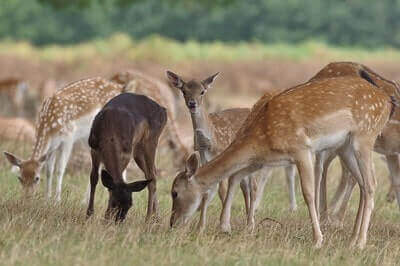
6. Trail Cameras
Using trail cameras when learning how to hunt fallow deer is a valuable tool that allows hunters to gather crucial information about deer movements, behavior, and patterns without disturbing their natural habitat. These motion-activated cameras can be strategically placed in areas frequented by fallow deer, such as feeding areas, trails, or bedding sites, to capture images or videos of passing deer.
By reviewing the footage collected by trail cameras, hunters can gain valuable insights into the size, age, and number of deer in the area, as well as their preferred travel routes and activity times. This information enables hunters to make informed decisions about where to set up stands or blinds, plan effective hunting strategies, and increase their chances of encountering and harvesting fallow deer.
Additionally, trail cameras can help hunters identify specific individual deer, track their movements over time, and monitor the progression of deer activity throughout the hunting season. Overall, incorporating trail cameras into the hunting process enhances the hunter’s ability to scout and strategize effectively, ultimately leading to a more successful and rewarding hunting experience for fallow deer.
If you need a quality trail camera, we did a review of the best trail cameras on the market today. The best climbing treestands can be read from this link.
7. Bait
Using bait when hunting fallow deer can be an effective strategy for attracting these elusive animals to specific locations, increasing the likelihood of a successful harvest. Hunters typically deploy bait such as corn, apples, or specially formulated deer feed in areas frequented by fallow deer, such as feeding areas or along travel routes.
Baiting can be particularly useful during times of scarcity or when natural food sources are limited, as it provides an additional incentive for deer to visit and linger in the vicinity. By strategically placing bait stations and using scent attractants to lure deer in, hunters can create opportunities for close encounters and clear shot opportunities.
However, it’s essential to follow local regulations and ethical guidelines when baiting for fallow deer, ensuring that baiting practices are conducted responsibly and sustainably. Additionally, hunters should exercise patience and remain concealed while waiting for deer to approach, as fallow deer can be cautious and easily spooked.
Overall, when used judiciously and in conjunction with other hunting techniques, baiting can be a valuable tool for hunters seeking to harvest fallow deer. If you need a blind, we did a review of the best hunting ground blinds.

8. Still-Hunting
Still hunting, also known as stalk hunting, is a method commonly employed by hunters when pursuing fallow deer. This approach involves moving slowly and quietly through the deer’s habitat, carefully scanning the surroundings for any signs of deer activity.
Hunters often utilize natural cover such as trees, bushes, and terrain features to conceal their movements and blend into the environment. By moving stealthily and remaining observant, hunters can increase their chances of encountering fallow deer, which are known for their keen senses and cautious nature.
Still hunting requires patience, persistence, and a keen eye for detail, as hunters must be prepared to react quickly when an opportunity presents itself. By employing this method, hunters can immerse themselves in the natural world, honing their tracking skills and increasing their chances of a successful harvest while enjoying the thrill of the hunt.
9. Get In Shape
Getting in shape is paramount for hunters planning to pursue fallow deer, as it directly impacts their ability to navigate through varied terrain and endure long hours in the field. Fallow deer inhabit diverse habitats ranging from dense woodlands to open grasslands, often requiring hunters to traverse rugged terrain, steep slopes, and challenging landscapes.
Being physically fit improves hunters’ endurance, agility, and overall mobility, allowing them to cover more ground effectively and quietly. Additionally, hunting fallow deer often involves extended periods of waiting and stalking, necessitating strength and stamina to remain alert and focused.
By prioritizing physical fitness through activities such as hiking, cardio exercises, and strength training, hunters can enhance their hunting experience, minimize fatigue, and increase their chances of success. Moreover, being in good shape reduces the risk of injury and ensures hunters can fully enjoy the physical and mental demands of the hunt, creating a more rewarding and fulfilling experience in the great outdoors.
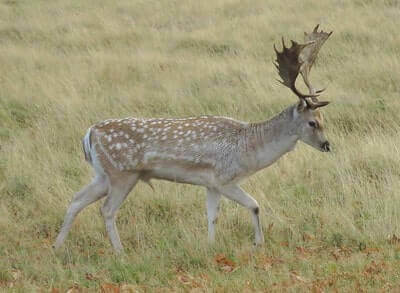
Fallow Deer Hunting Tips
1. The best time to hunt fallow deer is from September to December.
2. Fallow deer rut from late September through early November with the peak of the rut being October.
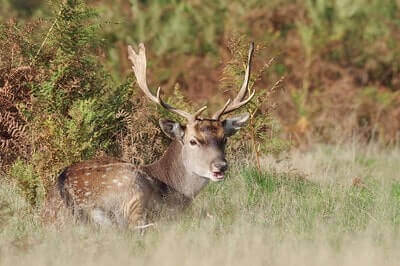
3. Fallow deer forbs and woody browse.
4. Fallow bucks become very aggressive during the rut as they move around grunting at each other and looking for does.

5. Fallow deer are often found in open grassy areas where they feed on green grass early mornings and late evenings.
6. In Texas, fallow deer is classified as an “exotic” species which means you can hunt it all year as there is no closed season regarding hunting exotics in Texas.
7. Fallow Bucks weigh about 250 pounds in September and about 200 pounds in November and December.
8. The does are smaller and weigh from 100 to 125 pounds.
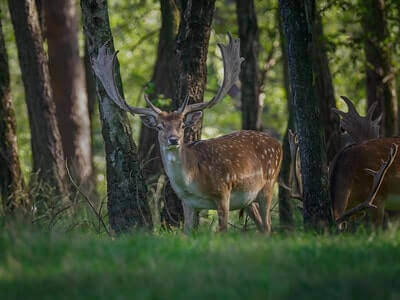
9. You can use predator calls to hunt fallow deer.
10. You can also use dogs to hunt fallow deer.
12. The spot & stalk hunting method is one of the most popular methods to hunt fallow deer.
13. You can hunt fallow deer with a hunting guide. The guide brings experience and knowledge to the hunt.

14. Fallow deer had a good sense of smell and eyesight.
15. Always hunt downwind of the area you want to hunt for fallow deer. If they pick up your human scent, the hunt will be over before you realize it.
16. If you hunt fallow deer during the fall and winter months when their food sources are scarce, you can set up a feeder and position your blind overlooking the feeder.
17. Get in shape to hunt fallow deer as the hunt can be physically demanding as you will most likely hunt in wide open areas and rough terrain.
18. You can also still-hunt fallow deer.

The Bottom Line
Fallow deer is one of the exotic species in Texas. This classification allows you to hunt them all year. Fallow deer are blessed with a great sense of smell and eyesight. Hunting fallow deer is challenging as your patience as a hunter, shooting skills, and physical fitness will be seriously tested.
In this article, we share information to help you successfully hunt the fallow deer. If you are also interested in hunting axis deer, then read how to hunt axis deer. You can also read how to hunt blacktail deer, how to hunt axis deer, how to hunt fallow deer, how to hunt sika deer, and how to hunt red deer.